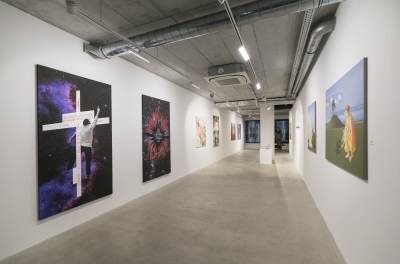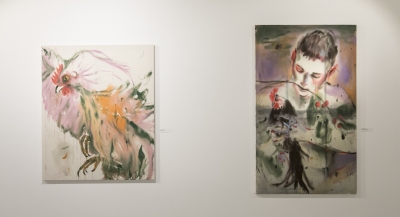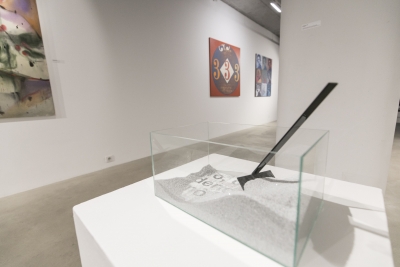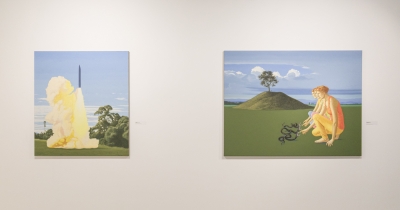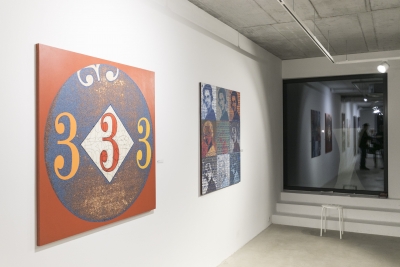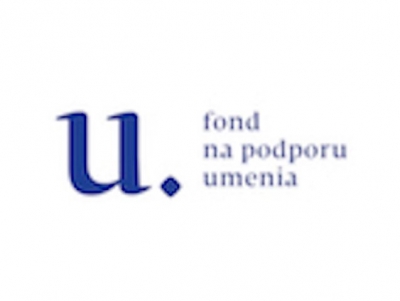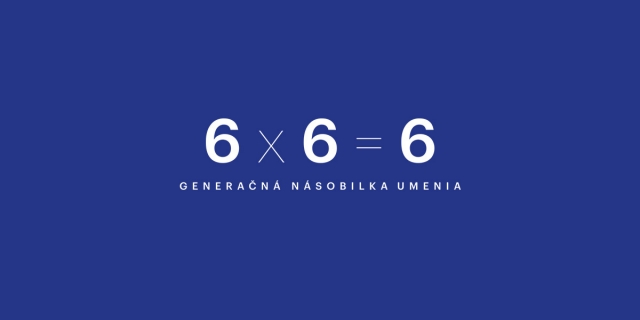
Collaboration among gallerists and the curator gave rise to this experimental exhibition project under the arithmetical equation of 6 x 6 = 6. The project complementarily illustrates the ambition of the newly-opened gallery, White & Weiss, to monitor contemporary developments within visual culture and to present and promote their leading figures, and concurrently to offer an opportunity for a unique art-historical rendezvous. Six addressed curators were challenged to go through their generational group (by the decade in which they were born) of artists and pick the one who they still consider as a unique and prominent figure on the Slovak visual art stage. This challenge, taken by six curators and six artists, produced the following six generational couples:
1930s Juraj Mojžiš – Eduard Ovčáček
1940s Eugénia Sikorová – Rudolf Sikora
1950s Katarína Bajcurová – Karol Pichler
1960s Vladimír Beskid – Bohdan Hostiňák
1970s Peter Tajkov – Erik Binder
1980s Silvia L. Čúzyová – Andrej Dúbravský
The set-up is primarily about a metaphoric curator-artist conversation, their generational inter-connection and perhaps personal friendships that were presented by the art historians within a short annotation on individual artists. Concurrently, it also is about a dialogue among art generations that are still active in the contemporary Slovak landscape that they also jointly co-shape. This exercise within a small space generated a polygon of author approaches and programs as well as a certain “sample” of coexistence and alternations of painting, a hanging picture and inter-media and post-conceptual approaches on the domestic stage. It becomes apparent in that way that painting keeps producing the genetic code of our visual civilization even if electronic media are now its nervous system. In the end, the exhibition also brings a little dose of actual visual art thinking that, in its essence, mirrors the contemporary art forms in our country.
vlado b.skid, coordinator and curator
EDUARD OVČÁČEK
Eduard Ovčáček was born on 5 March 1933 in Třinec. His boyhood years at the Czech-Polish near-border area were marked not only by the escalation of the international situation and war years but also by the “wilderness” and landscape along the Moravia River as well as a concoction of his schooling beginnings (The Institute of Economy, The Mining College Ostrava, The Academy of Fine Arts and Design Bratislava). The author was a participant in and co-organizer of the studio exhibitions titled Bratislava Confrontations that presented their program through works referring to abstract expression and structural painting. In the mid-1960s Ovčáček developed into one the most prominent figures of Lettrism and concrete poetry in Czechoslovakia and beyond.
Irony and sarcasm, undoubtedly of Kafkaesque provenance, was (and fortunately remained) the joining element of Ovčáček’s early art. Works that should be included are wooden totemic plastic pieces with burned engraved script and numerical signs, board pictures and relief-burned engraved pictures and landscapes, and a series of the Blue Collages and the White Collages of 1964-1965. They most apparently bear the above mentioned, clearly tattooed-in, wounded Kafkaesque world of transformations and (animal) burrows. The sarcastic points of Ovčáček’s art have not turned blunt even up to the present day. Just the same, there still is the creative use of series, metaphor variations and emotional signs. Of course, each of the outlined lines of Ovčáček’s art takes the merit of immanent development and poetic blanket and, a never-ending spiritual activity of critical cognitiveness.
Juraj Mojžiš
RUDOLF SIKORA
The post-war baby boomers (in their 70s now) entered their lives with a zealous effort to know, master and produce the “new art” – art that will not serve the interest of powerful people but will be a living soul of what was happening, a materialization of freedom, truth and art made free from any commands dictated by one or the other isms. Sikora, within his generation, originally was a painter of almost a transcendental imagination, a heretic reluctant to accept the Cartesian anthropocentric model of thinking. Sikora, searching for a new model of art-making and position to the world, was turning his attention to science, methods of scientific thinking, the theory of games and models. Collective activities, notoriously known in the so-called normalization, started to publicly appear through The First Open Studio in our house in Tehelna Street. There were more activities such as posters, exhibitions, meetings, presentations and lectures to underpin all the effort. The “Collective Existence” was determining the 1970s and most of the 1980s. This background, social responsibility, trust in science, collective engagement and discovering opportunities of the new media were drivers determining communication and Sikora’s art also in the following decades. After the change of the regime, when certain pathological societal phenomena disappeared, and new ones surfaced, the responsibility for the status of the world and the Earth has remained.
Eugénia Sikorová
KAROL PICHLER
He is an artist and a nomad, naturalized in France; after his longer period of living in Brazil he is now living in Lyon. He has not lost his bonds to Slovakia and the local setting to which he regularly returns to exhibit his works. His works, at a certain point of time, were over-bridging the post-modernism of the end of the 1980s and his neo-conceptual strategies, and can be characterized also with other dimensions reaching beyond, especially between applied and free art. He is a playful thinker engaging in captivating the viewers’ attention with the language, its reception, language plays and diverse (secret) cultural codes, and all of that brought him to develop a very specific language of his own, based on sign puzzles and rebuses. He works with the space, ready-made things and with objects in his installation setting and with his testing environment where he subjects us to various tests that often require active participation by the viewers. He likes soft, ephemeral materials and he can make his art work out of “nothing” and anything (such as food). And why Karol? Because we are peers and I like his art (even though this does not sound very art-historian-like) where the unprecedented “light-minded” wit and intellect are intertwined and because he always gives you a surprise with something new. Because day-to-day things as well as art make him happy, his company is enjoyable and I like recalling how he gave me a tour of a different Paris at one time. And also because in my life I observe his bans such as “ignoring reality is forbidden”; one that I look at every day.
Katarína Bajcurová
BOHDAN HOSTIŇÁK
The artistic activities by Bohdan Hostiňák (1968) in the Slovak landscape present a program-based, neoclassicist image-thinking with a mythical and mystical background. The artist, struck with his local East Slovakian landscape, Ruthenian iconographic painting, antique philosophy and European culture of a suspended picture, brings an imaginary, harmonious and Stoic world of figural pictures. I have been following his progress for over two decades (we jointly prepared also his first individual exhibition in Slovakia, in Košice in 1994, when he still was a student of the Academy of Fine Art and Design) and I consider him as one of the key artists of his generation in the Slovak setting and beyond.
In the course of the years he has been creating his own image dictionary of iconic signs and symbols. It is not about illusion-based or realistic painting but it is about a thought-over and sophisticated coded image-based language. At the beginning of his journey, there were primarily motifs of the ever-present fire, struggle and blood (Heraclites‘ cosmic fire, burning temples, Perun’s lightings, volcanoes, rain of blood droplets, burning sunsets, bonfires, rockets and similar). These days, the fiery images take turns with calm landscapes, focused on descending to the sources of cognition (logos of the world). There are tacit forest scenes, idyllic landscapes with low-set horizons, with introverted figures with “Greek” noses and favorite motifs from book studios and flickering flames. They are a pictorial transcription of Virgilian Arcadia, heathen holy forests as well as the concurrent need of the adventure of taking an intellectual shortcut.
Vladimír Beskid
ERIK BINDER
The generation born in the 1970s lived their childhood years in late socialism, their youth in wild capitalism and came of age in a skeptical period following the 9/11 attack. This “historical development” is to certain degree reflected also in the art by Erik Binder (1974). Erik owns a specific creative vital strength characteristic of several artists of his generation that, inter alia, has its roots in the distilling pot of the 1990s. The opaque pearl upon the Danube, where he was doing his studies that time, also left its special imprint. The power of Erik’s art does not dwell just in the extraordinarily-captured radiation of the outside world. Binder’s art primarily is a reflection of a rich internal imagination full of playful seriousness and serious playfulness, poetics, and paradox, contemplating peace and, last but not least, pure creative joy.
Peter Tajkov
ANDREJ DÚBRAVSKÝ
He is a talented, pondering, well-oriented, extravagant artist of the youngest generation who, fortunately, was discovered by the world. Young and beautiful, and now a nice maturing man in his 30s (oh, God, the time passes fast). He was born in 1987 and he already is the child of the 1990s when our country was finally flooded with the stream of freedom and capitalism. The climate and mentality of children born in 1981, such as the curator Silvia L. Čúzyová, among the last generation of the children of socialism, was different altogether. They would be lined-up, wearing their mandatory outfits and gym shoes, under the portrait of Gustav Husák, and they managed at least to be members of the socialist children’s “sparklets” and they remember the then greeting “Honor Labour”. “The difference between the years 1981 and 1987 is the same as it is between the emancipation effort by Madonna and the purely commercial show by Lady Gaga” (quote by Noro Lacko).
Silvia L. Čúzyová
Supported using public funding by Slovak Arts Council

